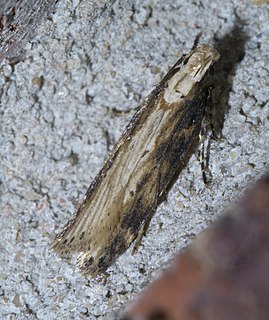| Chionodes fondella | |
|---|---|
| Scientific classification | |
| Kingdom: | |
| Phylum: | |
| Class: | |
| Order: | |
| Family: | |
| Genus: | |
| Species: | C. fondella |
| Binomial name | |
| Chionodes fondella (Busck, 1906) | |
| Synonyms | |
| |
Chionodes fondella is a moth in the family Gelechiidae. [1] It is found in North America, where it has been recorded from Nova Scotia to southern Manitoba, Montana, Colorado, Oklahoma, North Carolina and Pennsylvania. [2] [3]

Moths comprise a group of insects related to butterflies, belonging to the order Lepidoptera. Most lepidopterans are moths, and there are thought to be approximately 160,000 species of moth, many of which have yet to be described. Most species of moth are nocturnal, but there are also crepuscular and diurnal species.

The Gelechiidae are a family of moths commonly referred to as twirler moths or gelechiid moths. They are the namesake family of the huge and little-studied superfamily Gelechioidea, and the family's taxonomy has been subject to considerable dispute. These are generally very small moths with narrow, fringed wings. The larvae of most species feed internally on various parts of their host plants, sometimes causing galls. Douglas-fir (Pseudotsuga) is a host plant common to many species of the family, particularly of the genus Chionodes, which as a result is more diverse in North America than usual for Gelechioidea.

North America is a continent entirely within the Northern Hemisphere and almost all within the Western Hemisphere. It is also considered by some to be a northern subcontinent of the Americas. It is bordered to the north by the Arctic Ocean, to the east by the Atlantic Ocean, to the west and south by the Pacific Ocean, and to the southeast by South America and the Caribbean Sea.
The wingspan is 13–14 mm. The forewings are whitish ochreous, with each scale darker at the tip, and with a faint roseate tinge. There are two large conspicuous black costal spots, one at the basal third outwardly oblique, and the other at the apical third inwardly oblique, both reaching the middle of the wing. The extreme apical part of the wing is dusted with black. The hindwings are light ochreous fuscous. [4]

The wingspan of a bird or an airplane is the distance from one wingtip to the other wingtip. For example, the Boeing 777-200 has a wingspan of 60.93 metres, and a wandering albatross caught in 1965 had a wingspan of 3.63 metres, the official record for a living bird. The term wingspan, more technically extent, is also used for other winged animals such as pterosaurs, bats, insects, etc., and other fixed-wing aircraft such as ornithopters. In humans, the term wingspan also refers to the arm span, which is distance between the length from one end of an individual's arms to the other when raised parallel to the ground at shoulder height at a 90º angle. Former professional basketball player Manute Bol stands at 7 ft 7 in (2.31 m) and owns one of the largest wingspans at 8 ft 6 in (2.59 m).
The larvae feed on Antennaria , Anaphilis and Gnaphalium species, as well as Monarda fistulosa .

Antennaria is a genus of herbaceous perennial plants in the family Asteraceae, native to temperate regions of the Northern Hemisphere, with one species in temperate southern South America; the highest species diversity is in North America. Common names include catsfoot or cat's-foot, pussytoes and everlasting.

Gnaphalium is a genus of flowering plants in the sunflower family, commonly called cudweeds. They are widespread and common in temperate regions, although some are found on tropical mountains or in the subtropical regions of the world.

Monarda fistulosa, the wild bergamot or bee balm, is a wildflower in the mint family (Lamiaceae) widespread and abundant as a native plant in much of North America. This plant, with showy summer-blooming pink to lavender flowers, is often used as a honey plant, medicinal plant, and garden ornamental. The species is quite variable, and several subspecies or varieties have been recognized within it.

